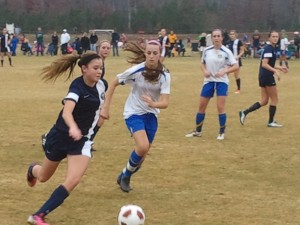Our Biggest Mistake: Talent selection instead of talent identification
 Many youth sports coaches claim to be great talent identifiers, and point to the results of their 11-year-olds’ all-star team as proof. Yet they are not talent identifiers. They are talent selectors. The difference could not be more striking, or more damaging to our country’s future talent pool in many sports.
Many youth sports coaches claim to be great talent identifiers, and point to the results of their 11-year-olds’ all-star team as proof. Yet they are not talent identifiers. They are talent selectors. The difference could not be more striking, or more damaging to our country’s future talent pool in many sports.
Talent selection is the culling of players with the current ability to participate and be successful in events taking place in the near future. Talent identification, on the other hand, is the prediction of future performance based upon an evaluation of current physical, technical, tactical and psychological qualities. Talent selection is pretty simple; talent identification is an art. One yields great results today; the other builds elite athletes and winning teams for the future.
Our current “win at all costs” youth sports culture promotes talent selection. When a coach is pressured to win by parents or a club, or when he or she feels the need to win to serve their own ego, that coach becomes a talent selector. When you are focused on talent selection, you are picking athletes to help you win now, and cutting ones that will not. You are looking at current athleticism, technical ability and traits to help achieve short-term success.
You naturally select the biggest, strongest and fastest young athletes, and play them extensive minutes. You limit playing time for the kids who are not up to snuff, and tell them they need to work harder, get tougher, etc., if they want to play more. You yell at them because they cannot get to the ball quick enough, or cannot shoot well enough to score. You tell them that this type of pressure is what they will face when they are older, so they better get used to it now.
Then, according to the latest statistics, 70 percent of them quit organized sports by the age of 13!
[ + More on this topic from John – Getting it right: Why “talent selection” doesn’t work well enough ]
On the other hand, talent identifiers are searching for young players who may not be elite athletes yet, but possess the physical and psychological attributes to eventually become one. Perhaps they have not yet grown, or been exposed to high-level coaching. Perhaps they are not as skillful yet, but show a high level of coachability, sensitivity to training and the motivation to learn. Identifying talent requires the skill to weigh all the physical, physiological, psychological and technical components of an athlete, as well as a measure of “gut instinct” of which kid has what it takes to become elite, and which kid does not.
Talent identification also takes a long-term approach to player selection and development, and focuses on training large numbers of players, instead of cutting all but the elite ones. It recognizes that many factors affect whether a kid will make it or not, but rarely are childhood results the main factor.
In a fascinating study on junior tennis players from 1994 through 2002, Piotr Unierzyski evaluated 1000 players age 12-13 in 50 different countries, a pool that included future stars Roger Federer, Kim Clijsters and others. His study (Click Here to Read More) found that of all these players, the ones who eventually made it into the Top 100 Professional Rakings were:
- Three to four months younger than the mean age for their group
- Slimmer and less powerful than their age group
- Usually faster and more agile than average
- They played less than the average number of matches that the top players did
- Their average practice hours per week were two to four hours less than the elite players in their age group
- Their parents were supportive, but not overly involved
 Let’s extrapolate this data onto the current elite youth athlete in the United States. Does a player who is young for his or her age, thinner and weaker, practices and plays less than their peers, and has parents who are not overly involved sound like today’s U-11 All Star? Not that I have seen. Now, I know that is quite an oversimplification, but do you get my point here?
Let’s extrapolate this data onto the current elite youth athlete in the United States. Does a player who is young for his or her age, thinner and weaker, practices and plays less than their peers, and has parents who are not overly involved sound like today’s U-11 All Star? Not that I have seen. Now, I know that is quite an oversimplification, but do you get my point here?
American youth sports are far too often focused on talent selection, and not talent identification. We are committed to winning now, to getting on ESPN, or achieving some hypothetical pre-pubescent national ranking. Yes, some team sport clubs have B and C teams and develop large numbers of players. Others have those same B and C teams, and players are often jettisoned there with less experienced coaches, less committed teammates and an overall lesser experience.
We say we are developing them for the future, but all too often we are using them to balance the budget. We select the current talent that will help us win now, because if we do not, the club down the road will grab them and win, and our best players will leave. We are not identifying and developing the kids who are most likely to become elite competitors after puberty. We are selecting the ones who already are elite, but often do not have the characteristics needed for long term elite performance.
This is why the emphasis on winning prior to high school is destroying youth sports. This is why nations with 1/100th of our population can compete with us on a world stage in many sports. They actually identify and develop future talent, instead of selection based upon current results. Our wealth and sheer numbers allow us to succeed internationally, but other nations are slowly but surely closing the gap in nearly every sport because quite frankly, they identify and develop talent far better than we do.
How do we fix this? Here are a few simple thoughts for youth sports that to be honest, should not be that hard to implement:
- Stop cutting players at young ages, and develop large numbers of players instead of just the elite ones. I recently read that Sweden, for example, produces more NHL players per capita than any other country, and they do not cut players until age 17. Hmmm.
- Focus on developing all players at the youngest ages, with particular attention given to helping the less skilled ones catch up technically to the stronger ones. Thus, when they finish their growth spurt, we have a much larger pool of adequately skilled individuals to choose from, instead of just the kids who happened to have facial hair at 12 but stopped growing at 13.
- Put an end to the win at all costs nature of pre-pubescent sports, especially things like state and national championships prior to middle or high school, and televising events like the Little League World Series (which has run since 1946 and produced a whopping 27 Major League Baseball players in that time). OK, admittedly, this one might be tough to implement!
- Better educate our coaches to understand the difference between selecting and identifying talent, and then teach and encourage them to develop it rather than try and win with it immediately.
 This is just a start, but unless we start making some drastic changes to our youth sports system, we will see smaller nations continuing to close the gap, and eventually surpass the United States in many sports. We are not elite in soccer yet because of the culture. We are falling behind in baseball because of it. Even in basketball, the gap has been significantly reduced. Why? Because our competitors are not relying on a player development system that is often based upon a large population and dumb luck.
This is just a start, but unless we start making some drastic changes to our youth sports system, we will see smaller nations continuing to close the gap, and eventually surpass the United States in many sports. We are not elite in soccer yet because of the culture. We are falling behind in baseball because of it. Even in basketball, the gap has been significantly reduced. Why? Because our competitors are not relying on a player development system that is often based upon a large population and dumb luck.
[ + More on this topic from John – Getting it right: Why “talent selection” doesn’t work well enough ]
The best part about making all these changes? Our clubs and schools will have larger numbers of skilled athletes to choose from, as well as additional healthier and well rounded kids. We will have families who are less stressed both financially and anxiety-wise, because their kids can just be kids again, and they don’t feel pressured to have their 10-year-olds travel 2,000 miles to play a game. We will allow coaches to actually coach, and develop both better people and better athletes.
Abundant skilled players? Lower costs? Less time devoted to youth sports and more to family and school? More success for our national teams and elite individual athletes?
These are changes worth making.
Please share your thoughts below on this article. Do you agree? Disagree? How can we change this?
—
SOCCERWIRE MARKETPLACE
- The St James FC Boys Travel Tryouts
- OFFICIAL BAYERN MUNICH SUMMER CAMPS U.S.
- JOIN THE ALLIANCE!
- OFFICIAL FC BARCELONA CAMPS U.S.
- The Cup San Diego - Hosted by Legends FC
- Players Wanted - Undergraduate or Post-graduate
- Head Coach - South Region at The St. James FC
- Travel Coach - North Region at The St. James FC
- Program Manager - Chantilly at The St. James FC
- Girls Director of Player Development: South Region












